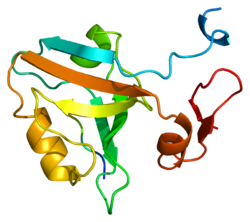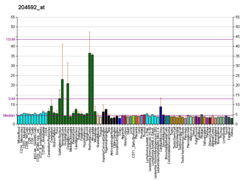PSD-95 (postsynaptic density protein 95) also known as SAP-90 (synapse-associated protein 90) is a protein that in humans is encoded by the DLG4 (discs large homolog 4) gene.[5][6][7]
PSD-95 is a member of the membrane-associated guanylate kinase (MAGUK) family. With PSD-93 it is recruited into the same NMDA receptor and potassium channel clusters. These two MAGUK proteins may interact at postsynaptic sites to form a multimeric scaffold for the clustering of receptors, ion channels, and associated signaling proteins.[5] PSD-95 is the best studied member of the MAGUK-family of PDZ domain-containing proteins. Like all MAGUK-family proteins, its basic structure includes three PDZ domains, an SH3 domain, and a guanylate kinase-like domain (GK) connected by disordered linker regions. It is almost exclusively located in the post synaptic density of neurons,[8] and is involved in anchoring synaptic proteins. Its direct and indirect binding partners include neuroligin, NMDA receptors, AMPA receptors, and potassium channels.[9] It plays an important role in synaptic plasticity and the stabilization of synaptic changes during long-term potentiation.[10]
- ^ a b c GRCh38: Ensembl release 89: ENSG00000132535 – Ensembl, May 2017
- ^ a b c GRCm38: Ensembl release 89: ENSMUSG00000020886 – Ensembl, May 2017
- ^ "Human PubMed Reference:". National Center for Biotechnology Information, U.S. National Library of Medicine.
- ^ "Mouse PubMed Reference:". National Center for Biotechnology Information, U.S. National Library of Medicine.
- ^ a b "Entrez Gene: DLG4 discs, large homolog 4 (Drosophila)".
- ^ Cho KO, Hunt CA, Kennedy MB (Nov 1992). "The rat brain postsynaptic density fraction contains a homolog of the Drosophila discs-large tumor suppressor protein". Neuron. 9 (5): 929–942. doi:10.1016/0896-6273(92)90245-9. PMID 1419001. S2CID 28528759.
- ^ Stathakis DG, Hoover KB, You Z, Bryant PJ (Nov 1997). "Human postsynaptic density-95 (PSD95): location of the gene (DLG4) and possible function in nonneural as well as in neural tissues". Genomics. 44 (1): 71–82. doi:10.1006/geno.1997.4848. PMID 9286702.
- ^ Hunt CA, Schenker LJ, Kennedy MB (Feb 1996). "PSD-95 is associated with the postsynaptic density and not with the presynaptic membrane at forebrain synapses". Journal of Neuroscience. 16 (4): 1380–1388. doi:10.1523/JNEUROSCI.16-04-01380.1996. PMC 6578559. PMID 8778289.
- ^ Sheng M, Sala C (2001). "PDZ domains and the organization of supramolecular complexes". Annu. Rev. Neurosci. 24: 1–29. doi:10.1146/annurev.neuro.24.1.1. PMID 11283303.
- ^ Meyer D, Bonhoeffer T, Scheuss V (2014). "Balance and stability of synaptic structures during synaptic plasticity". Neuron. 82 (2): 430–43. doi:10.1016/j.neuron.2014.02.031. PMID 24742464.






